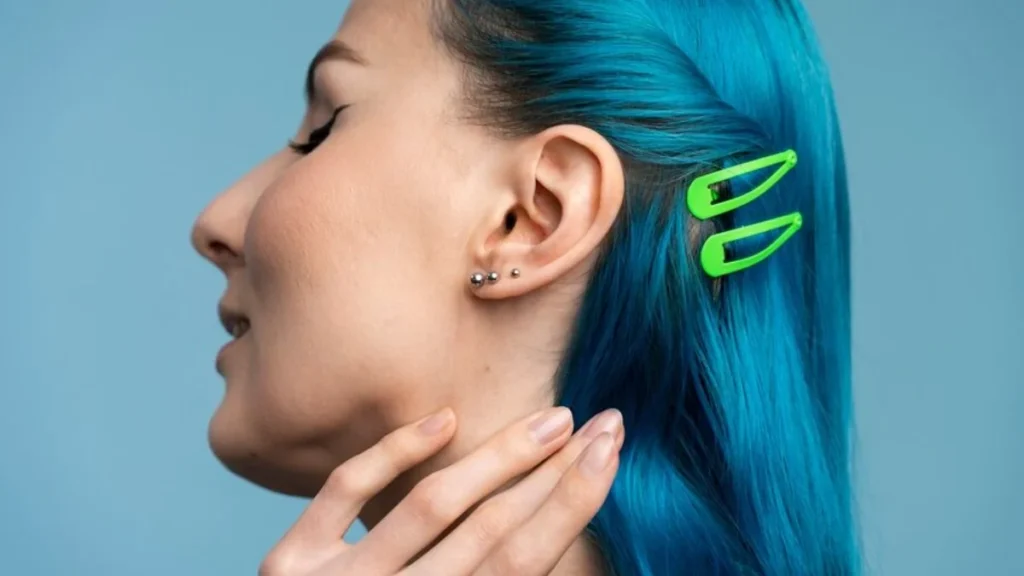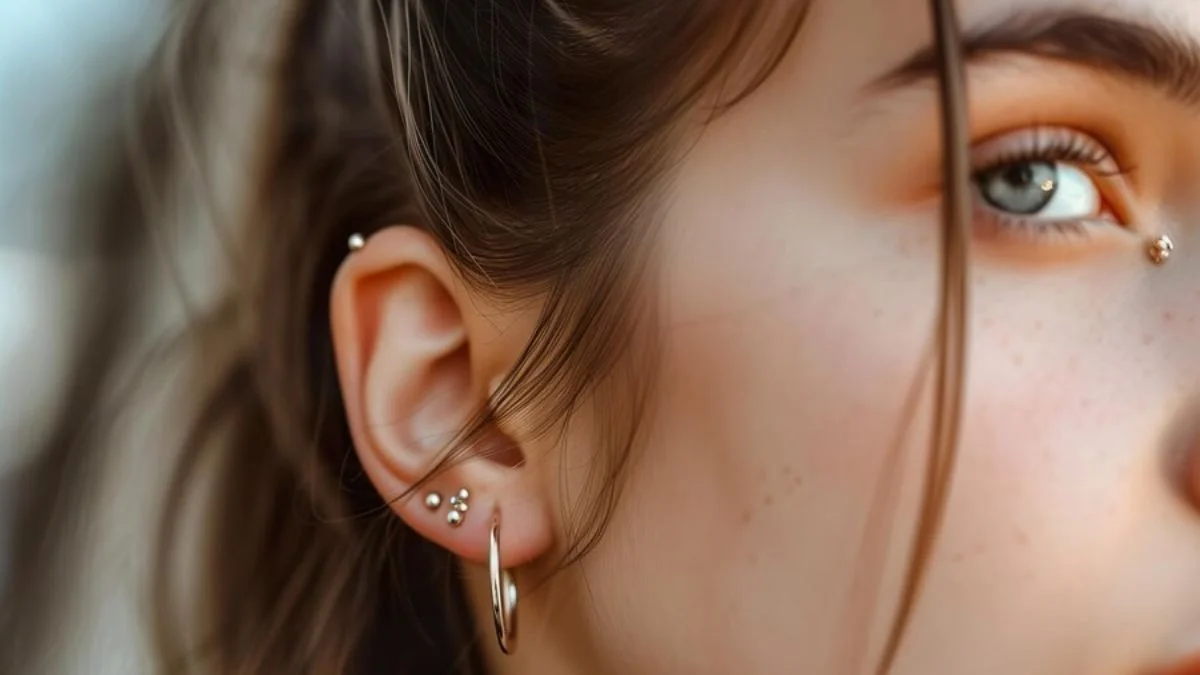Body piercings have long been a form of self-expression, allowing individuals to personalize their appearance in subtle or bold ways. Among the variety of piercings available today, the forward helix piercing has gained popularity for its aesthetic appeal and versatility. Located on the upper outer cartilage of the ear, just above the tragus, this piercing offers a stylish way to enhance your look, whether you opt for a single, double, or triple forward helix piercing. In this article, we will explore everything you need to know about forward helix piercings, including the piercing process, jewelry options, pain levels, healing times, and the overall benefits of this trendy yet timeless piercing.
What is a Forward Helix Piercing?
A forward helix piercing is placed on the upper outer cartilage of the ear, in the small area above the tragus. This location is ideal for those looking to stack multiple piercings, as the forward helix offers limited yet perfect space for single, double, or even triple piercings. For those who appreciate the aesthetic of delicate, minimalist piercings, the forward helix is a great choice. It pairs beautifully with other ear piercings, such as the tragus, lobe, or even rook piercing, allowing you to create a curated ear that reflects your personality.
The Piercing Process
The process for getting a helix piercing is fairly straightforward, but it’s important to seek out a professional piercer who has experience with cartilage piercings. Unlike earlobe piercings, cartilage piercings require precision and care to avoid complications.
Step 1: Consultation
Before the piercing, your piercer will discuss placement options, especially if you’re considering a double forward helix or triple forward helix piercing. They will clean the area thoroughly and mark the spot(s) where the piercing(s) will be placed.
Step 2: The Piercing
- Using a hollow needle, the piercer will make a quick, clean puncture through the cartilage. Due to the thickness of cartilage, this process may be slightly more uncomfortable than an earlobe piercing, but it is generally quick.
Step 3: Initial Jewelry Insertion
- A longer stud will be inserted initially to accommodate any swelling that may occur after the piercing. Once the piercing is fully healed, you can switch to a snugger piece of helix jewellery, such as a clicker hoop or smaller stud.

Helix Jewellery: Styles and Options
One of the key appeals of forward helix piercings is the wide variety of jewelry available. From tiny studs to elegant hoops, the options are virtually limitless. However, when it comes to selecting helix jewellery, it’s important to choose materials that are safe for healing cartilage, such as surgical-grade steel, titanium, or 14k gold.
Studs:
For a minimalistic look, many people opt for simple studs. These can range from tiny diamonds or gemstones to plain metallic balls. Studs are also ideal for initial piercings since they cause less irritation during the healing process.
Forward Helix Hoops:
- After your piercing has fully healed, you can experiment with helix hoops. These small rings hug the curve of the ear and add a stylish twist to the piercing. Some people prefer hoops for their second or third piercing in a double or triple helix setup, creating a stacked look.
Double and Triple Forward Helix Piercing Stacks:
- For those who want to make a statement, double or triple forward helix piercings are becoming increasingly popular. This involves getting multiple forward helix piercings placed vertically along the cartilage, allowing for layered studs or hoops for a bold, yet elegant look.
Forward Helix Pain: What to Expect
A common concern with any piercing is the level of pain involved. Since the helix piercing is located on cartilage, it is generally more painful than an earlobe piercing. However, pain tolerance varies from person to person. Most people describe the pain as a sharp pinch followed by a throbbing sensation that subsides after a few minutes.
Pain Level:
- On a scale from 1 to 10, with 1 being the least painful and 10 being the most, the forward helix piercing typically falls around a 5 or 6. If you’re opting for a double or triple forward helix piercing, the pain may increase slightly, but the process is still relatively quick and bearable.
Helix Healing Time and Aftercare
One of the most important aspects of getting a cartilage piercing, such as the forward helix, is understanding the healing process. Cartilage piercings take longer to heal than earlobe piercings due to the density of the tissue. The helix healing time can range from 3 to 9 months, depending on individual factors such as aftercare, immune system health, and whether you experience any complications.
Aftercare Routine:
To ensure your piercing heals properly, it’s crucial to follow a strict aftercare routine:
- Clean the piercing twice a day with a saline solution or a piercing aftercare spray.
- Avoid touching or twisting the jewelry, as this can introduce bacteria and irritate the piercing.
- Be cautious when sleeping, as pressure on the piercing can cause discomfort and prolong healing.
- Avoid swimming in pools, lakes, or the ocean, as water can introduce harmful bacteria to the piercing site.
Once the piercing is fully healed, you can switch to smaller or decorative jewelry like a forward helix hoop for a more polished look.
Helix Piercing Benefits
There are several benefits to choosing a helix piercing. First and foremost, it offers a unique and attractive way to customize your appearance. Whether you go for a single, double, or triple helix piercing, you can create a stunning ear stack that complements other piercings.
Aesthetic Appeal:
The forward helix piercing is both subtle and eye-catching, making it a great option for those who want something different from the standard lobe or cartilage piercing.
Versatility:
- With the variety of forward helix jewellery options available, you can easily change your look to suit different occasions. From elegant diamond studs to sleek hoops, the possibilities are endless.
Low Maintenance:
- Once healed, forward helix piercings are relatively low maintenance. With proper aftercare during the healing period, they don’t require much attention, making them a practical choice for those with busy lifestyles.
Double and Triple Forward Helix: What You Need to Know
If you’re considering more than one helix piercing, a double or triple forward helix setup offers a stunning look. These piercings are placed vertically along the cartilage, allowing for a stacked appearance that can be customized with different jewelry styles.
Pain and Healing Time:
- The pain level for a double or triple helix piercing will naturally be higher than for a single piercing, as more holes are being made in a sensitive area. The healing time for multiple helix piercings can be similar to that of a single piercing, but may extend slightly due to the increased trauma to the cartilage.
Jewelry Selection:
- For double or triple forward helix piercings, many people opt for a combination of studs and hoops, creating a layered effect that adds dimension to the ear.
Conclusion
forward helix piercing is a stylish and versatile choice for anyone looking to enhance their appearance with a unique ear piercing. Whether you opt for a single piercing or stack up with a double or triple forward helix, the options for customization are endless. With the right aftercare, you can enjoy this elegant piercing for years to come.
Forward Helix Piercing FAQs
1. How much does a forward helix piercing hurt?
The pain level for a forward helix piercing is moderate, usually around a 5 or 6 on a scale of 1 to 10. The pain is sharper than that of an earlobe piercing, but it is quick and manageable.
2. How long does it take for a forward helix piercing to heal?
The healing time for a helix piercing typically ranges from 3 to 9 months, depending on aftercare and individual healing rates.
3. What jewelry is best for a forward helix piercing?
For the initial healing period, it’s recommended to wear a longer stud to accommodate swelling. Once healed, you can switch to smaller studs or forward helix hoops.
4. Can I get a double or triple forward helix piercing?
Yes! Double and triple helix piercings are popular for creating a stacked look. Be prepared for a slightly longer healing time and a bit more discomfort due to multiple piercings.
5. What are the benefits of a forward helix piercing?
Forward helix piercings offer a unique aesthetic that can be customized with various jewelry styles. They are versatile, low maintenance, and complement other ear piercings well.
6. How do I care for my helix piercing during healing?
Keep the piercing clean by using a saline solution twice a day, avoid touching or twisting the jewelry, and be cautious of putting pressure on the piercing while sleeping.









